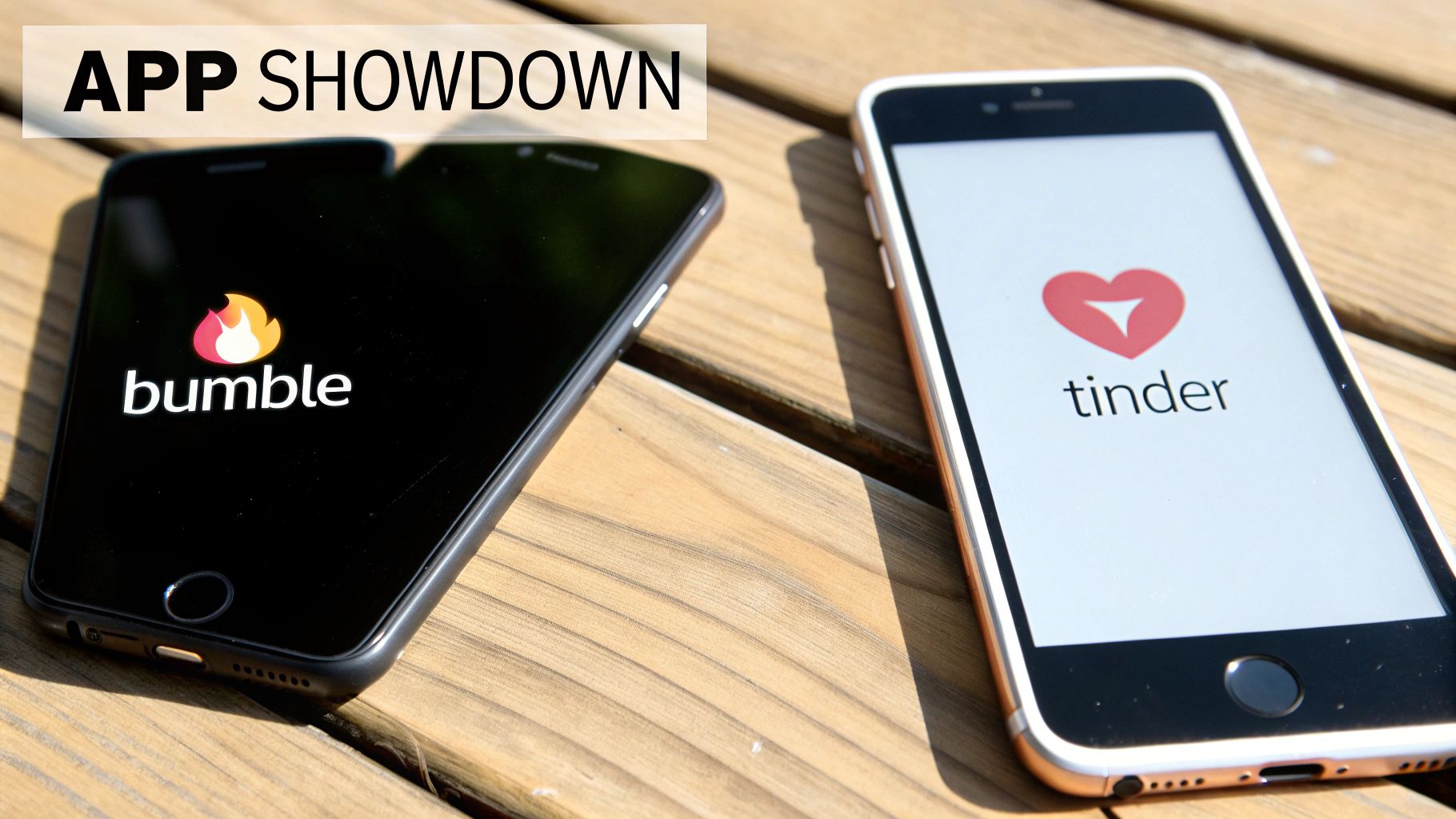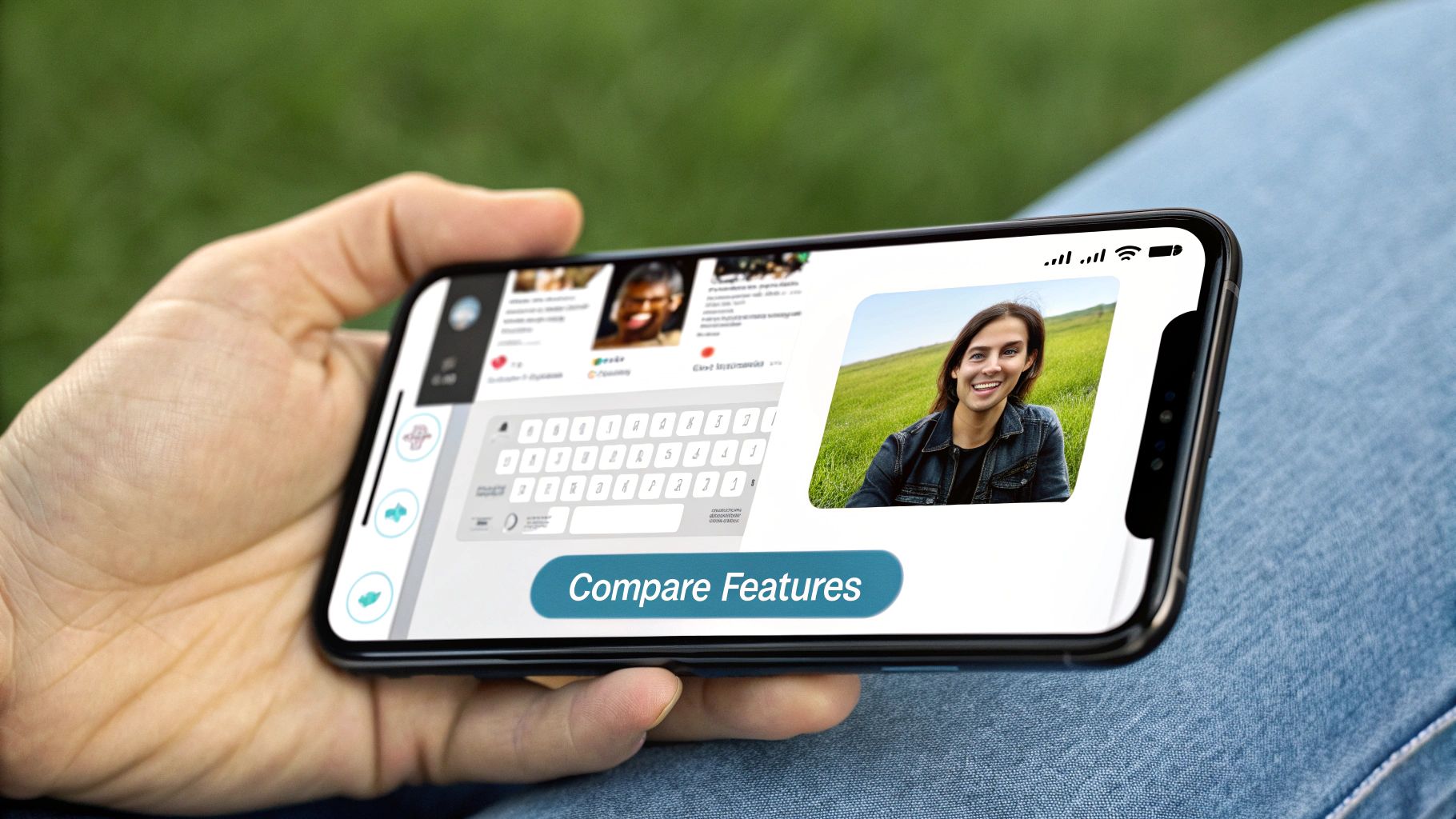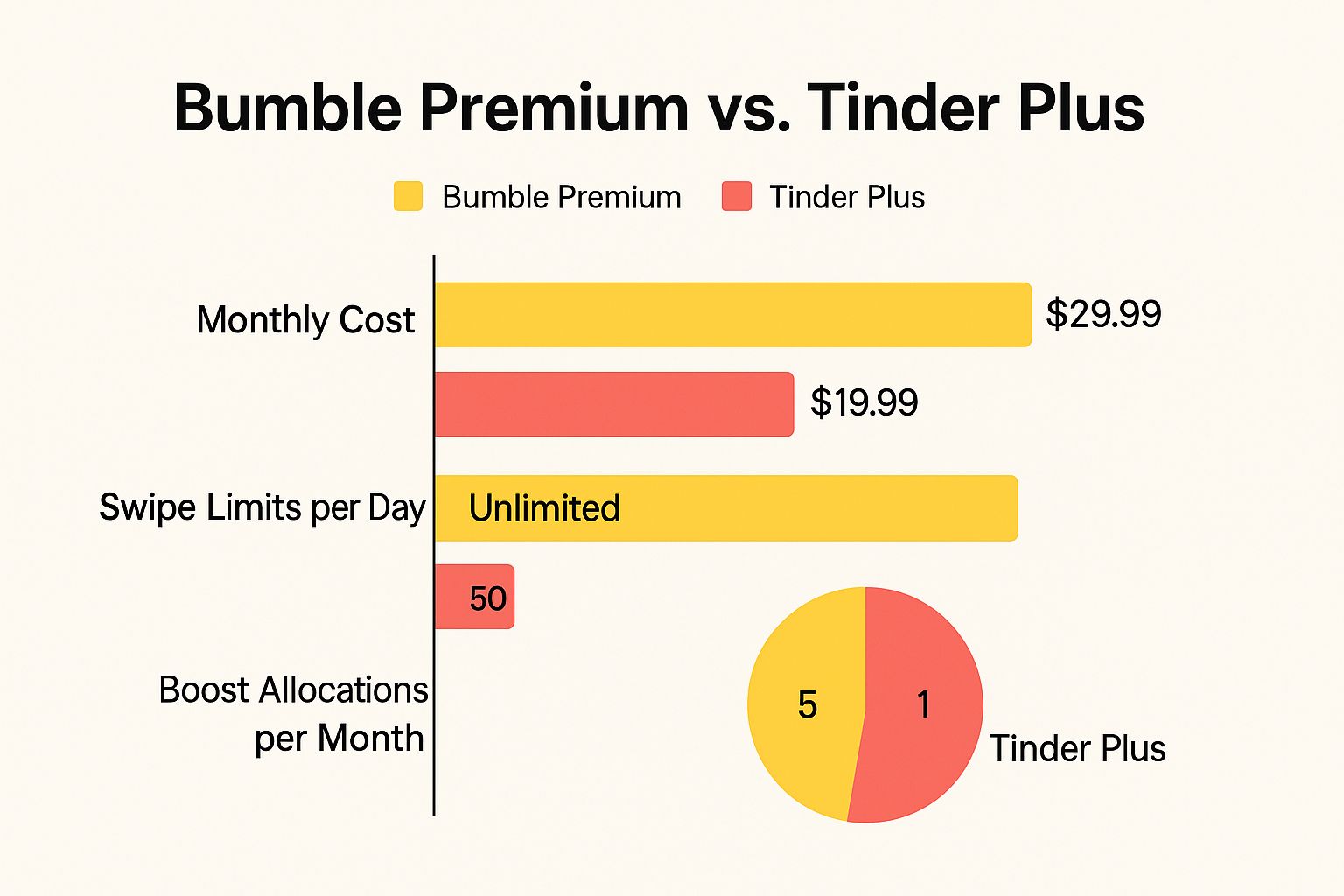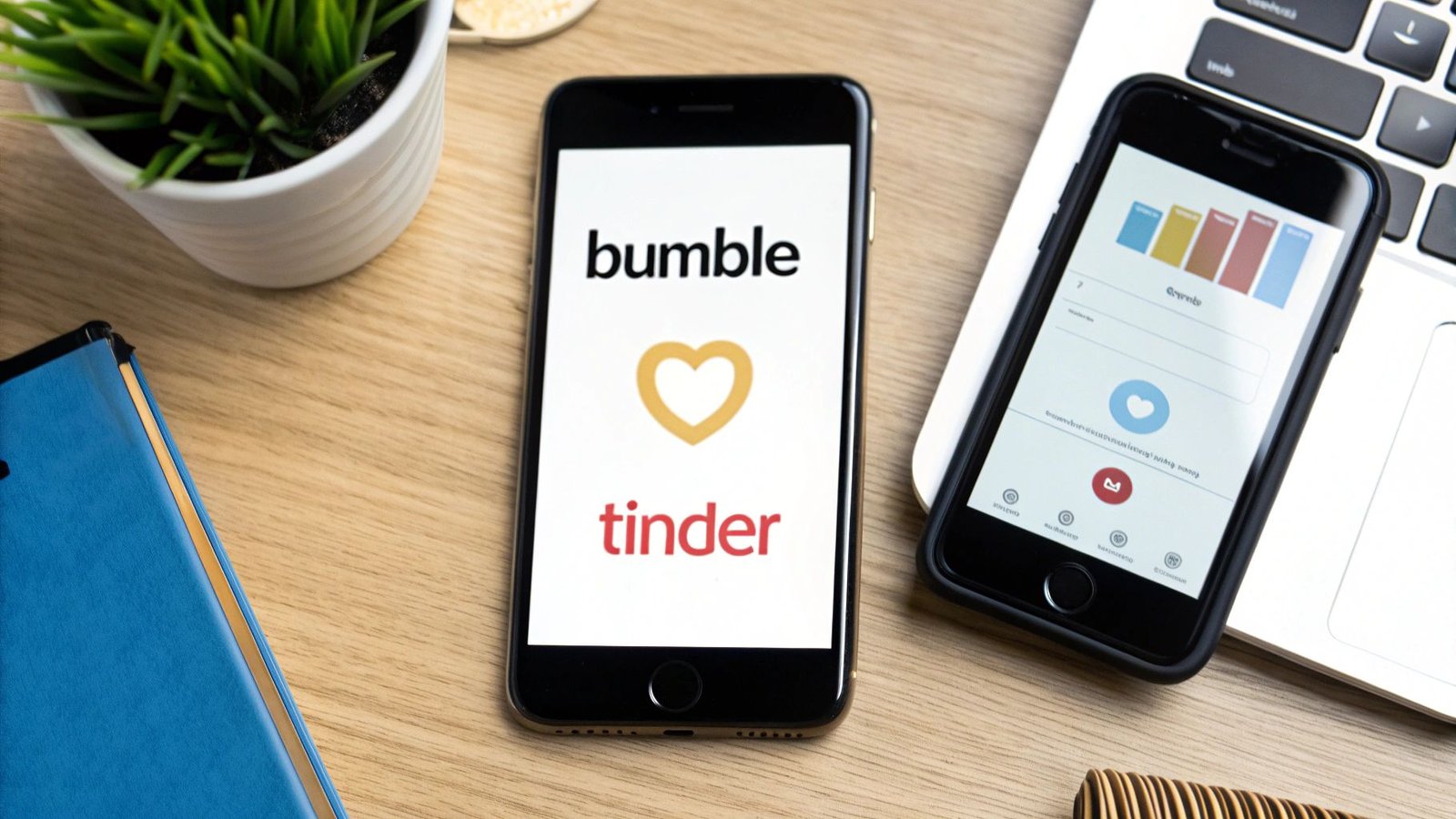Understanding Why Your Choice Actually Matters

Deciding between the major players in the dating app scene often feels like a debate with no definitive answer. Friends might passionately endorse one over the other, but few explain the why behind their loyalty. This choice isn't about finding the single 'best' app, because one doesn't exist. The real task is to figure out which platform’s design and social environment truly aligns with your dating goals and personality. The Bumble or Tinder discussion is less about feature lists and more about the psychological experience each app creates.
Your choice of app influences more than just who you see; it shapes how you approach the dating process itself. Each app has its own distinct ecosystem that guides user behaviour, the quality of conversations, and even your own sense of confidence. This is precisely why someone might find great success on one platform while feeling completely overlooked on another. It all comes down to a matter of personality-platform fit.
The Psychology of the Swipe
It helps to think of these apps as different social venues. Tinder often resembles a bustling, high-energy nightclub; it's filled with possibilities but demands that you take the initiative to cut through the noise and forge a real connection. In contrast, Bumble can feel more like a structured social event, where the core rule—women message first—encourages more deliberate interactions from the very beginning.
This structural difference is significant, as it directly affects the user base and the expectations they bring to the app. This distinction is gaining importance as user behaviours change. A recent report highlighted a noticeable decline in UK dating app usage, with Tinder losing 594,000 users and Bumble losing 368,000. This trend suggests that daters, particularly those under 34, are becoming more discerning about where they spend their time, looking for communities that better suit their social and romantic ambitions. You can find out more about the latest UK online dating trends on Ofcom.org.uk.
The Reality Behind User Numbers and What They Mean For You
When weighing up Bumble or Tinder, it's easy to treat user numbers as the final word. However, raw statistics only provide a partial view; it's the real-world experience those numbers shape that truly matters. While a larger user base might seem superior, its practical effect on your dating life can be complex.
Quality Over Quantity: The Tinder Effect
Tinder's substantial user pool means a higher volume of potential matches, which is appealing if you want to keep your options open. The downside of this scale is a well-documented phenomenon known as choice overload. Faced with too many profiles, it becomes harder to commit to a single conversation, often leading to more superficial interactions and a greater likelihood of "ghosting" as users move to the next potential match.
This scale is especially evident in the UK. Recent data highlights Tinder's market leadership, with 1.9 million users in May 2023, significantly more than its rivals. Hinge is next with 1.4 million, followed by Bumble with 1.1 million. This means Tinder offers the largest possible audience but also represents the most competitive environment. You can discover more about UK online dating usage on Statista.com.
The Case for a Curated Community
In contrast, Bumble's smaller community tends to produce a different type of user engagement. With fewer users, there's a sense that each potential match holds more weight, which can encourage more thoughtful profile curation and opening messages. The app’s central feature—women making the first move—acts as a natural filter, attracting users who are comfortable with this dynamic and often resulting in more intentional conversations from the start.
Consider the difference between a huge music festival and a niche, genre-specific gig. The festival offers more variety, but the focused event guarantees you'll be surrounded by people with a shared interest. For daters looking for serious connections, Bumble's "smaller pond" can feel less overwhelming and yield higher-quality interactions, even if the total number of matches is lower. This is a critical point to consider, particularly as the app's parent company expands its market presence; you can read more about Bumble's journey in our article.
Ultimately, the best choice depends on your personal strategy: do you prefer casting a wide net or fishing in more selective waters?
How Each Platform Changes Your Dating Behaviour

The crucial difference in the Bumble or Tinder discussion is not in their feature lists, but in how their fundamental mechanics shape your actions. The platforms do more than just show you different people; they encourage distinct versions of you to emerge. This psychological shift is a direct result of the rules of engagement each app has, leading to very different social atmospheres.
The Power Shift: Initiative and Investment
Bumble's signature feature—women making the first move—sends ripples through the entire user experience. For men, this alters the dynamic from active pursuit to strategic patience. The emphasis shifts from writing the perfect opening message to creating a profile that's compelling enough to invite one. This can lessen the fatigue that comes with sending many messages that get few replies, a frequent issue on other platforms.
For women, being required to initiate conversation reverses the conventional dating dynamic. It gives them direct control, letting them establish the conversational direction immediately. While this can be empowering, it also puts the onus on them to begin every interaction. This is a significant departure from Tinder, where the responsibility for starting a chat is shared and, by social norm, often falls to men. This single rule is the main reason some users excel on one app while feeling entirely out of their element on the other.
Conversation Quality and User Persona
These behavioural shifts have a direct impact on the quality of interactions. Tinder's open messaging system can result in a greater volume of low-effort openers, as some users might take a "quantity over quality" stance to see what works. This environment can sometimes foster a more casual, direct, and almost gamified approach to dating.
On the other hand, Bumble’s 24-hour time limit for the first message introduces a sense of urgency and purpose. Women are encouraged to message matches they are truly interested in, and men must respond in a timely manner, which helps to screen out low-investment interactions. This framework often leads to conversations that start with more substance than a generic "hey."
The platform's design guides users towards more thoughtful communication. It subtly influences them to adopt a dating persona focused on making a strong, memorable first impression. The perceived pressure to craft an engaging opener is so significant that some users even seek external help from ghostwriters, not to be deceptive, but to present the most articulate version of themselves.
To better understand how these design choices play out in the real world, the table below breaks down their influence on user behaviour and interaction quality.
| User Experience Element | Bumble Impact | Tinder Impact |
|---|---|---|
| Initiating Contact | Women-led. This filters for intent and can lead to higher-quality opening lines from women who are genuinely interested. Men's role is passive initially, focusing on profile appeal. | Open to all. This can result in a higher volume of low-effort openers, often from men, following traditional social scripts. The responsibility is mutual but often falls to men by convention. |
| Time Constraints | The 24-hour reply window for the first message and response creates urgency, filtering out low-investment matches and encouraging prompt, focused communication. | No time limits on messaging. This allows for more casual, intermittent conversations but can also lead to chats fizzling out due to a lack of urgency or perceived low priority. |
| Conversational Tone | Generally fosters more intentional and substantive conversations from the start, as the initiator has already invested thought into making the first move. | Can be a mixed bag. The high volume of matches may lead to more generic "hey" or "hi" openers as users cast a wide net. Conversations may lean more towards casual and spontaneous interactions. |
| User Mindset | The structure encourages a mindset geared towards "quality over quantity." Users, particularly women, are more selective about who they initiate contact with. | Often encourages a "swiping game" or "quantity over quality" mindset. The focus can be on accumulating matches rather than nurturing individual conversations. |
| Relationship Intent | The platform's design and branding attract users who are often perceived as being more serious about finding a relationship, influencing them to communicate accordingly. | Caters to a broader spectrum of intentions, from casual hook-ups to serious relationships. This wide range is reflected in the varied communication styles and effort levels. |
This analysis shows that the app you choose does more than just offer a different pool of people; it actively shapes your approach to online dating. The subtle rules and constraints guide your communication style, level of investment, and ultimately, the kind of connections you are likely to make.
The Real Cost of Finding Love (And What You Get For It)
Beyond the subscription fees, the true cost of using a dating app like Bumble or Tinder is measured in your time, emotional investment, and the actual quality of the connections you make. While many users focus on the monthly price tag, a deeper analysis reveals a more complex value proposition. The central question is whether paying for premium features genuinely improves your chances of finding a good match or if you're simply paying for tools that don't alter the core experience.
Are Premium Features a Good Investment?
Both Bumble and Tinder have built their business models around the idea that a paid subscription can solve common dating frustrations. The free versions are functional enough to draw you in but are deliberately limited to make the premium tiers look like a necessary upgrade. Features such as unlimited swipes or the ability to see who has liked your profile (Bumble's Beeline vs. Tinder's Likes You) are marketed as essential tools for success.
However, their practical worth is highly dependent on your individual circumstances. For example, unlimited swipes on Tinder could be useful in a densely populated city like London, where the sheer volume of users is immense. In contrast, on Bumble, where the platform encourages a more considered approach, the standard swipe limit is often more than adequate. The key is to evaluate whether a feature solves a genuine problem in your dating strategy or merely provides a temporary feeling of having more control.
The infographic below illustrates the basic cost and feature distribution for entry-level premium subscriptions.

This visual data shows that while the pricing structures are comparable, the core offerings—such as daily swipe limits and monthly Boosts—vary considerably, directly influencing the paid user's experience on each platform.
To help you decide if an upgrade is worth the money, let's break down the practical value of key paid features. The following table offers a cost-benefit analysis of what you get and whether it provides a real return on your investment in the search for a connection.
| Feature Category | Bumble Premium | Tinder Plus/Gold | Real-World Value |
|---|---|---|---|
| Visibility of Admirers | Beeline: See who has already liked you. | Likes You: See a grid of people who have swiped right on you. | High ROI for the time-poor user. This feature cuts out guesswork, allowing you to focus only on guaranteed matches. It's the single most impactful paid feature on either app for saving time. |
| Unlimited Swiping | Unlimited Swipes | Unlimited Swipes | Situational ROI. In a major city, this can be useful. In less populated areas, you'll likely run out of new profiles quickly, making this feature redundant. Its value is tied directly to the size of your local user base. |
| Profile Priority | Spotlight: Pushes your profile to the top of the stack for 30 minutes. | Boost: Pushes your profile to the top of the stack for 30 minutes. | ROI is dependent on profile quality. A Boost on a well-crafted profile during peak hours (e.g., Sunday evening) can be very effective. However, boosting a weak profile offers a poor return. |
| Advanced Filtering | Advanced Filters: Filter by education, height, political leaning, etc. | (No Direct Equivalent) | High ROI for users with specific criteria. If you have clear deal-breakers or preferences, this saves immense time by removing incompatible matches from your queue. Less useful for those with a more open-minded approach. |
| Global Matching | Travel Mode: Change your location to swipe in other cities. | Passport: Change your location to swipe anywhere in the world. | Niche ROI. Excellent for planning dates before a trip or for people who travel frequently. For most users who date locally, this feature offers little to no practical benefit. |
This analysis shows that the 'best' features are those that directly address a bottleneck in your personal dating process, such as a lack of time or a desire for specific partner qualities.
Maximising Your True Return
Ultimately, the best value is not found in a subscription tier but in a well-executed strategy. Before you consider paying, you must first ensure your profile is optimised. High-quality photos, a well-written bio, and engaging prompts will always deliver a higher return than any paid feature alone.
Think of it this way: using a Boost on a weak profile is like paying for a prime-time television advert for a poorly made product. In contrast, a strong profile on a free plan will consistently outperform a mediocre one with a premium subscription. Your most valuable asset is the time and effort you invest in presenting yourself authentically and compellingly—an investment that yields dividends regardless of your budget.
Safety Beyond The Marketing: What Actually Protects You

When evaluating Bumble or Tinder, user safety is a critical consideration that goes deeper than simple marketing claims. Both platforms feature standard tools like photo verification and reporting mechanisms, but their practical application and underlying philosophies differ. The true effectiveness of these safety measures is determined by how they are implemented and how consistently each app upholds its own community standards.
Verification and Proactive Moderation
Tinder’s safety approach includes a blue tick verification system, which confirms a user's identity through submitted photos. While this is a useful step in reducing obvious catfishing, it is fundamentally a reactive system. The responsibility falls on users to identify and be wary of profiles that lack verification.
In contrast, Bumble has built a reputation on a more proactive stance. The platform uses a mix of AI algorithms and human moderators to actively scan for inappropriate content. This can lead to users being banned for rule violations even before another user files a report.
Bumble also introduced its "Private Detector" tool, a feature designed to directly combat a common form of online harassment. It automatically blurs potentially explicit images, allowing the recipient to decide whether to view, block, or report the content without being unwillingly exposed.
This proactive approach is a cornerstone of Bumble's brand identity, as seen in their safety and support materials.

By prominently featuring their commitment to a clear code of conduct, photo verification, and robust reporting, Bumble integrates safety into the core of the app experience.
Real-World Application and User Responsibility
Although Bumble’s design appears more focused on safety, its effectiveness is not absolute. The rule requiring women to message first may foster a sense of security, but it doesn't prevent problematic behaviour once a conversation is underway. On both platforms, personal vigilance remains essential. Users should always be cautious about sharing sensitive information and prioritise meeting in public for first dates.
Ultimately, app features are only one part of the equation; building confidence for real-world meetings is equally important. Many of the skills needed for a safe and successful first date are universal. If you are looking to improve your in-person dating skills, our guide on the top speed dating tips for a successful experience offers relevant advice.
While Bumble offers more integrated tools to manage online interactions, your personal safety strategy is the most important protection you can have, no matter which app you use.
Cracking the Code: How Each Algorithm Really Works
Forget the vague explanations found in official help sections; the true mechanics of dating app algorithms are revealed through their real-world behaviour. These systems aren't just random shufflers of profiles. They are complex, goal-oriented codes built to maximise user engagement and, ultimately, revenue. Understanding how they operate is crucial when choosing between Bumble or Tinder.
Tinder’s Algorithm: The Elo Score Legacy
Tinder's algorithm has a well-known history, once using an "Elo score," a system borrowed from professional chess that ranked users based on their perceived desirability. While Tinder states it has moved beyond this specific model, the underlying principle appears to persist: your profile is assigned a value based on how other people interact with it.
Here’s a practical breakdown of what this means for you:
- Initial Boost: New profiles frequently get a temporary surge in visibility. The algorithm uses this phase to collect data on how many right swipes you get from a diverse audience, which helps to establish your initial ranking.
- Swiping Behaviour: The algorithm observes your own swiping patterns. Being overly selective, or conversely, swiping right on every profile, can harm your visibility. A balanced approach signals to the system that you are a thoughtful and engaged user.
- Engagement Matters: It’s not just about getting matches; it’s about starting conversations. The algorithm rewards profiles that not only match but also participate in active chats. A match that leads to a message exchange is valued far more than one that remains silent.
In essence, Tinder’s system operates like a competitive marketplace. Profiles that consistently perform well—receiving right swipes and sparking conversations—are shown more often to other high-performing profiles.
Bumble’s Algorithm: A Focus on Active Participation
Bumble’s algorithm shares some foundations with Tinder's, like rewarding high-quality profiles and active engagement, but its core women-make-the-first-move feature introduces a significant difference. Because women must start conversations within 24 hours, the algorithm heavily favours users who are both active and responsive.
Key elements for Bumble’s system include:
- First-Move Incentive: The entire platform is structured around the first message. The profiles of women who consistently initiate conversations are likely to be shown to more men. Likewise, men who reply promptly to these opening messages are considered more desirable by the system.
- Profile Completeness: Bumble's interface encourages users to create detailed profiles using badges, prompts, and thorough bio information. The algorithm seems to prefer profiles that are fully filled out, as this suggests a greater level of user investment and seriousness.
- Recency of Use: Both apps favour recently active users, but Bumble’s time-sensitive matching makes this even more critical. Logging in often and engaging with your matches keeps your profile in active circulation, preventing it from going stale and being deprioritised by the algorithm.
Making The Right Choice For Your Dating Reality
The decision between Bumble or Tinder isn't about which app is universally "better", but which one aligns with your individual circumstances. Your lifestyle, relationship ambitions, and how you prefer to communicate all shape your dating reality. The most effective platform is the one that fits into this reality, not one that forces you to adapt to it. A one-size-fits-all approach rarely works; instead, a strategic choice based on self-awareness is key.
The Busy Professional vs. The Thoughtful Introvert
For a time-poor professional, efficiency is everything. Dating must be slotted into a demanding schedule, so every interaction needs to have purpose. Tinder's massive user base might seem like a benefit at first, offering a high volume of potential matches. However, the reality can be a significant time drain, spent sifting through profiles and engaging in low-effort conversations.
- Recommendation for Professionals: Bumble frequently emerges as the more practical option. Its core mechanic, where women must make the first move, acts as a natural filter. Men spend less time on speculative outreach and more on assessing genuinely interested matches. Women, in turn, can manage the conversation flow, investing their limited time only where they see real potential. This structure encourages more deliberate and serious initial interactions.
On the other hand, an introvert who prioritises meaningful conversation over superficial small talk needs a different kind of environment. Tinder's fast-paced, high-volume nature can feel overwhelming. The pressure to create a profile that shouts the loudest in a crowded room might not appeal to someone who connects on a more substantive level.
- Recommendation for Introverts: Once again, Bumble tends to provide a more suitable setting. The platform's culture encourages more thoughtful opening messages, which aligns well with an introverted communication style. It creates a space where a well-written bio and clever prompts are more likely to be noticed and appreciated, setting the foundation for the deeper conversations they are looking for.
When to Recognise It's Time for a Change
How can you tell if your chosen app isn't delivering? The signs are often quite clear: you feel more drained than excited by the process, your matches seldom convert into conversations, and the interactions you do have feel misaligned with what you want. If you are on Tinder searching for a long-term relationship but primarily match with people seeking casual encounters, it may be time to switch. Conversely, if you find Bumble’s pace too slow and want more immediate interaction, Tinder could offer a better experience.
A successful transition involves more than just installing a new app; it requires a shift in strategy. A profile that performs well on Tinder might not be effective on Bumble, and vice versa. Your biography, photo selection, and particularly your opening lines must be adapted to the new platform’s unspoken rules and user expectations. If you're finding it difficult to craft that initial outreach, our guide on how to impress with a first message on a dating app offers practical, platform-specific advice.
Ready to find the right dating path for you? Explore our expert guides and app reviews on DatingBlog.co.uk to make your next move with confidence.

